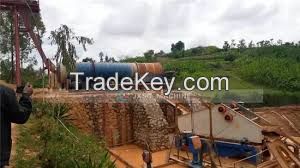Product Description
Coltan, short for columbite-tantalite, is a metallic ore primarily
composed of two minerals: columbite (a niobium-rich mineral) and
tantalite (a tantalum-rich mineral). Tantalum is a valuable metal
used in various electronic devices, particularly in capacitors, due
to its high capacitance and reliability. Here are some key points
about coltan (tantalite ore):
- Composition:
Coltan typically consists of varying proportions of columbite and
tantalite minerals. Tantalum content in coltan can range from a
few percent to over *0%, depending on the specific ore deposit.
- Occurrence: Coltan
is found in several regions around the world, including Central
Africa, Australia, Brazil, and Canada. However, the Democratic
Republic of Congo (DRC) in Central Africa is known to have
significant coltan reserves, and it has been a major producer of
coltan ore.
- Extraction: Coltan
mining often involves small-scale and artisanal mining
operations, particularly in the DRC and neighboring countries.
The extraction process can involve both traditional methods, such
as manual labor and basic tools, as well as more mechanized
operations.
- Uses: Tantalum
extracted from coltan ore is a critical component in the
electronics industry. It is primarily used to manufacture
tantalum capacitors, which are widely used in electronic devices
like smartphones, laptops, tablets, and other consumer
electronics. Tantalum is also used in the production of
high-temperature alloys for aerospace applications, as well as in
medical implants and superalloys.
- Challenges and
Controversies: The mining of coltan has been associated with
various social, economic, and environmental challenges,
particularly in the DRC. These include issues such as conflict
financing, human rights abuses, child labor, environmental
degradation, and exploitation of local communities. The trade in
coltan has been linked to funding armed groups in the region,
leading to international efforts to promote responsible sourcing
practices and transparency in the supply chain.
- Regulation and
Certification: Efforts have been made to establish certification
schemes and traceability initiatives to ensure that coltan is
mined and traded responsibly. Organizations such as the
Conflict-Free Sourcing Initiative (CFSI) and the Responsible
Minerals Initiative (RMI) work to promote responsible mineral
sourcing practices and support transparency in global supply
chains.
Overall, coltan tantalite ore plays a significant role in the
global electronics industry, but its extraction and trade are
accompanied by various social, economic, and environmental
challenges that need to be addressed through responsible sourcing
practices and international cooperation.
Coltan, short for columbite-tantalite, is a metallic ore primarily
composed of two minerals: columbite (a niobium-rich mineral) and
tantalite (a tantalum-rich mineral). Tantalum is a valuable metal
used in various electronic devices, particularly in capacitors, due
to its high capacitance and reliability. Here are some key points
about coltan (tantalite ore):
- Composition:
Coltan typically consists of varying proportions of columbite and
tantalite minerals. Tantalum content in coltan can range from a
few percent to over *0%, depending on the specific ore deposit.
- Occurrence: Coltan
is found in several regions around the world, including Central
Africa, Australia, Brazil, and Canada. However, the Democratic
Republic of Congo (DRC) in Central Africa is known to have
significant coltan reserves, and it has been a major producer of
coltan ore.
- Extraction: Coltan
mining often involves small-scale and artisanal mining
operations, particularly in the DRC and neighboring countries.
The extraction process can involve both traditional methods, such
as manual labor and basic tools, as well as more mechanized
operations.
- Uses: Tantalum
extracted from coltan ore is a critical component in the
electronics industry. It is primarily used to manufacture
tantalum capacitors, which are widely used in electronic devices
like smartphones, laptops, tablets, and other consumer
electronics. Tantalum is also used in the production of
high-temperature alloys for aerospace applications, as well as in
medical implants and superalloys.
- Challenges and
Controversies: The mining of coltan has been associated with
various social, economic, and environmental challenges,
particularly in the DRC. These include issues such as conflict
financing, human rights abuses, child labor, environmental
degradation, and exploitation of local communities. The trade in
coltan has been linked to funding armed groups in the region,
leading to international efforts to promote responsible sourcing
practices and transparency in the supply chain.
- Regulation and
Certification: Efforts have been made to establish certification
schemes and traceability initiatives to ensure that coltan is
mined and traded responsibly. Organizations such as the
Conflict-Free Sourcing Initiative (CFSI) and the Responsible
Minerals Initiative (RMI) work to promote responsible mineral
sourcing practices and support transparency in global supply
chains.
Overall, coltan tantalite ore plays a significant role in the
global electronics industry, but its extraction and trade are
accompanied by various social, economic, and environmental
challenges that need to be addressed through responsible sourcing
practices and international cooperation.
| Country: |
Cameroon |
| Model No: |
-
|
| FOB Price: |
47 ~ 55 / Tonne ( Negotiable ) (Negotiable)
Get Latest Price
|
| Place of Origin: |
Democratic Republic of Congo |
| Price for Minimum Order: |
47 per Tonne |
| Minimum Order Quantity: |
20 Ton |
| Packaging Detail: |
Metal Drums |
| Delivery Time: |
32 |
| Supplying Ability: |
2000 Tonne per Month |
| Payment Type: |
- |
| Product Group : |
- |






